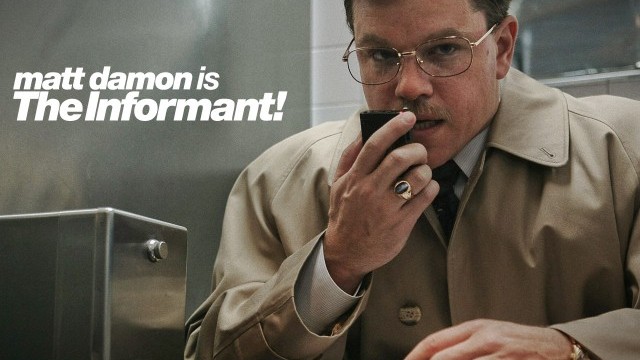“There should be a TV show about a guy who calls home one day and he’s there, he answers, he’s talking to himself, only he’s someone else. He’s somehow divided into two, and the second one of him drives away and the rest of the show is about him trying to find the guy.”
The early tell in this film that teaches you how to watch it, how to integrate the anachronistic stylings of the titling and scoring evocative of ’70s cheese, is when Mark Whitacre gazes out onto a building-in-progress of his across the street from his Midwestern manse, and his voice over narration, peppered with oddball observations and pop culture references, rambles into his thoughts on a local food court. He mentions a Mexican place, and the soundtrack subtly, briefly shifts from its chintzy ’70s tone to mariachi horns, and this is all it takes to understand that these out-of-place signifiers of another era (the film is set in the ’90s, based on a true story involving price-fixing lysine to the tune of billions in fraudulent payouts) are the way that Mark Whitacre views his world. He is the protagonist of his own cheerful, espionage-style story, and everything that occurs is colored with his manic interpretation of events. Were it not for these goofy touches Soderbergh infuses the material with, the film would have been far more of a corporate thriller or drama, like The Firm or Rising Sun. All the reference points for Whitacre are in the movies and TV shows of his youth – even his close contacts in the FBI, who become almost as friends to him, include Scott Bakula (of Quantum Leap fame) as real-life figure Brian Shepard. Most of the other government agents, attorneys, and accountants include comedians and comic actors like Joel McHale, Tony Hale, and Patton Oswalt, serving as straight men to Mark Whitacre and his utterly bizarre personality (Matt Damon’s performance is incredible for its seeming blandness, which becomes more apparently unhinged as it goes on).
As mentioned before, Mark Whitacre considers himself the protagonist of his own story, the good guy versus the bad guys (“You look at yourself wearing a white hat and they’re all wearing black hats?” “Yeah, something like that!”). As he gathers evidence for the FBI’s investigation into ADM, he becomes increasingly gleeful and awestruck at how cool the wiretapping and arrests become, in an aw-shucks sort of way. Yet this all seems to hide additional motive, an ambition to rise to the head of the company that is so delusional in its thinking that the other characters can’t help but literally drop their jaws in how audacious it is. As the plot progresses and the extent to which Whitacre has been embezzling money out of the company becomes more apparent, Whitacre’s own attempts at rationalization for his actions become obvious, and the cracks in the performance he leads start to show. This all culminates in the film’s most poignant and serious moment, when the whole pop facade falls away as Mark is finally cornered in the lies he has spun. The narration, confidently attempting to forward lies through Mark’s mouth, becomes disentangled as he attempts to continue sputtering excuses; Mark has bisected into two people entirely, and his and his wife’s realization that this cannot go on gains some real pathos.
Mark at one point muses over blue and orange and yellow Central American butterflies with poisonous wings, enough to stop a bird’s heart, but the birds don’t eat them; meanwhile, another butterfly looks the same but lacks the poison, “looking dangerous, getting by on their looks.” What better way to describe the bizarre enigma that is Mark Whitacre.

